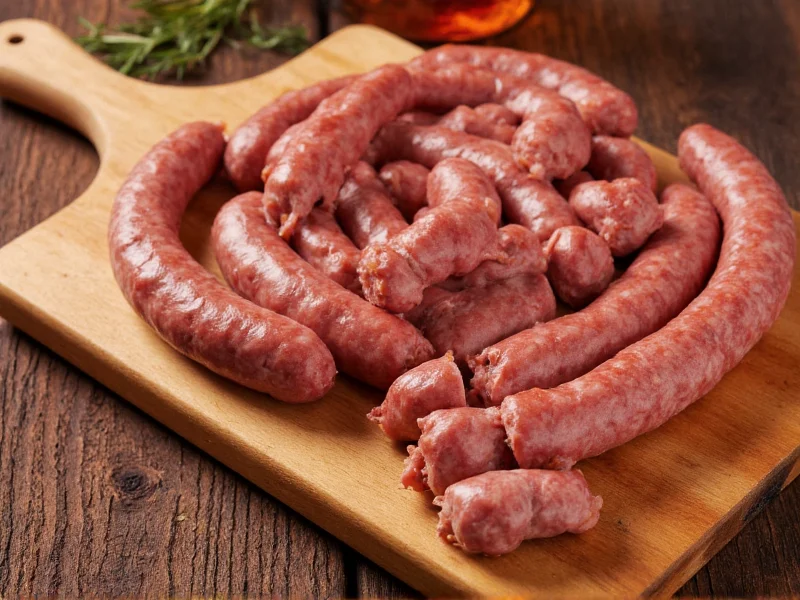Understanding what is summer sausage begins with its unique preservation method. Unlike fresh sausages that require immediate refrigeration, summer sausage uses a combination of curing agents, controlled fermentation, and often smoking to create a product stable at room temperature. This characteristic made it historically valuable for soldiers and travelers who needed non-perishable protein sources during warmer months—hence the name "summer" sausage.
Historical Origins of Summer Sausage
The tradition of making what is summer sausage dates back to European butchers who developed preservation techniques before refrigeration existed. German and Swiss immigrants brought these methods to America in the 19th century, where the practice evolved using locally available meats including venison. Originally called "sommerwurst" in German (meaning "summer sausage"), these sausages allowed families to preserve meat through hot seasons without spoilage.
How Summer Sausage Is Made
The production process for what is summer sausage involves several critical steps that differentiate it from fresh sausages:
- Meat selection: Typically a blend of coarsely ground beef and pork (sometimes venison or other game meats)
- Curing: Addition of salt, sodium nitrite, and sometimes sugar to prevent bacterial growth
- Fermentation: Introduction of bacterial cultures that lower pH and create tangy flavor
- Smoking (optional): Exposure to low-temperature smoke for flavor and additional preservation
- Drying: Controlled reduction of moisture content to achieve proper texture
This multi-step preservation process creates the distinctive characteristics people associate with what is summer sausage: a firm texture that slices cleanly, a slightly tangy flavor profile, and remarkable shelf stability.
| Characteristic | Summer Sausage | Regular Fresh Sausage |
|---|---|---|
| Preservation Method | Cured, fermented, smoked | None (requires refrigeration) |
| Shelf Life (unopened) | 6-12 months at room temperature | 1-2 days refrigerated |
| Texture | Firm, sliceable | Soft, crumbly |
| Flavor Profile | Tangy, complex | Simple meat flavor |
| Refrigeration Needed | Only after opening | Always |
Key Ingredients in Summer Sausage
When exploring what is summer sausage made of, several components work together to create its distinctive properties:
- Meat: Usually 70% lean beef with 30% pork fat for optimal texture and flavor balance
- Curing salts: Sodium nitrite prevents botulism and fixes the pink color
- Dextrose: Feeds fermentation bacteria and balances acidity
- Spices: Traditional blends include mustard seed, black pepper, garlic, and coriander
- Starter culture: Bacterial cultures that initiate controlled fermentation
The specific ratio of ingredients determines whether the final product qualifies as what is summer sausage versus other cured meats. Authentic summer sausage maintains 35-40% moisture content after processing, which is higher than traditional dry sausages like salami but lower than fresh sausages.
Storage and Handling Guidelines
One of the most frequently asked questions about what is summer sausage concerns storage. Properly manufactured summer sausage remains shelf-stable for 6-12 months when unopened due to its low water activity and acidic pH. Once opened, it requires refrigeration and should be consumed within 3 weeks.
For optimal quality, store unopened summer sausage in a cool, dark place away from temperature fluctuations. Avoid freezing as this can damage the texture. When slicing, use a sharp knife on a clean cutting board to prevent contamination—this addresses common concerns about does summer sausage need to be refrigerated after opening.
Serving Suggestions and Pairings
Understanding what is summer sausage includes knowing how to serve it properly. This versatile meat shines in multiple applications:
- Serve thinly sliced as part of a charcuterie board with aged cheeses and crusty bread
- Add to sandwiches with mustard and sauerkraut for a hearty lunch option
- Chop and incorporate into breakfast scrambles or omelets
- Pair with sweet accompaniments like fig jam or apple slices to balance the tanginess
- Use in recipes requiring pre-cooked meat, such as casseroles or pasta dishes
The distinctive flavor profile of what is summer sausage makes it particularly compatible with bold beverages. Try pairing it with medium-bodied red wines like Merlot, malty beers such as amber ales, or even bourbon-based cocktails that complement its smoky notes.
Regional Variations and Modern Adaptations
While traditional what is summer sausage follows European methods, regional variations have emerged across North America. Wisconsin-style summer sausage often features a higher garlic content, while Southern versions sometimes incorporate smoked paprika. Modern adaptations include turkey summer sausage for leaner options and jalapeño-infused varieties for heat lovers.
Game meat versions using venison, elk, or bison have gained popularity among hunters and specialty meat enthusiasts. These variations maintain the essential preservation characteristics that define what is summer sausage while offering unique flavor profiles based on the protein source.
Safety Considerations for Homemade Summer Sausage
Many enthusiasts wonder how to make what is summer sausage at home. While possible, proper food safety practices are critical. Home producers must maintain strict temperature control during fermentation (typically 90-100°F for 24-48 hours) followed by proper smoking temperatures. Using tested recipes with precise curing salt measurements prevents botulism risk.
Commercially produced summer sausage undergoes rigorous testing for pH levels (typically 4.6-5.2) and water activity (0.85-0.92) to ensure safety. When purchasing, look for products with clear ingredient lists and manufacturing dates to verify quality—this addresses common concerns about is summer sausage safe to eat without cooking.











 浙公网安备
33010002000092号
浙公网安备
33010002000092号 浙B2-20120091-4
浙B2-20120091-4